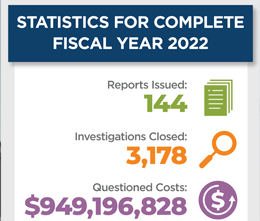
OIG Ends Another (Fiscal) Year
There’s another month until January 1, but the USPS OIG and the rest of the federal government have already finished 2022. Our fiscal year (FY) ended on September 30.
This past year was our 25th anniversary, and we worked hard to provide oversight of the Postal Service and share our work with the Postal Service’s stakeholders including Congress and the public. Among many, here are a few things we are particularly proud of:
- We participated in three Congressional hearings describing the results of our audits of service problems around the country and a fourth hearing on the Postal Service’s acquisition of electric delivery vehicles.
- Our Office of Audit’s new Field Operations Review Team began conducting quick reviews of multiple facilities in specific cities and areas of the country experiencing service challenges. Looking at processing and delivery facilities together helps us get a better picture of why service problems are happening.
- As part of its work stopping mail theft by postal employees, our Office of Investigations increased its focus on the theft and mishandling of arrow keys – the universal keys used to open both centralized delivery boxes and blue collection boxes.
Our Fall Semiannual Report to Congress or SARC gives the stats. Over the entire FY 2022, we issued 144 reports and closed 3,178 investigations. You’ll also find a trove of other data that paints a detailed picture of our work.
As the OIG embarks on its next 25 years, what do you think we should focus on? Let us know in the comments below.
